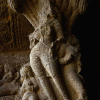The residents of the Bagori village are Jadh Bhotiyas who shifted to this location after the 1960s Indo-China political conflict. Bhotiyas are originally an ethno-linguistic tribe along the trans-Himalayan belt. They inhabited the high-altitude regions (from 6500 to 13000 ft) of the Indian central Himalaya at the Indo-Tibetan and Indo-Nepal borders. In India, Bhotiya community settlements are found in the states of Jammu and Kashmir, Himachal Pradesh, Uttarakhand, Sikkim, Assam, Arunachal Pradesh, Uttar Pradesh, West Bengal and Tripura.[1] Formerly, their primary occupation was sheep rearing and trans-Himalayan trade.[2] The geographic location of their settlements played a vital role in the intermixing and assimilation of the Tibetan-Hindu culture. The various dialects of the language spoken by them has strong similarity to the eastern subgroup of the Tibeto-Burman language family. Most Bhotiyas are multilingual and speak Hindi, Garhwali and Nepali, in addition to their mother tongue, Rongpa. Their ability to communicate in multiple languages was one of the reasons for their domination in trans-Himalayan trade. Today, the Bhotiya people characterise themselves as Hindus. However, former scholars and early explorers have emphasised on the Tibetan origin and Buddhist influences on their cultural practices and distinguish them from major local Hindu population in these mountain valleys called ‘Paharis’.
The Bhotiyas of Uttarakhand are scattered over the seven main river valleys in the three border districts of India and Tibet. These three high-altitude border districts of Uttarakhand are Pithoragarh in Kumaon division, and Chamoli and Uttarkashi districts in Garhwal division. (Fig 1) They reside in the Indian central Himalayan valleys of Garhwal and Kumaon divisions of Uttarakhand on the Bhagirathi river system and Kali (or Sarda) river system.
The Bhotiya community consists of Suryavanshis, Chandravanshis, Rajputs and Thakurs. Their language Rongpa, derived from the Tibetan rung (valley) and pa (inhabitants), has strong similarities with the Tibetan language. As per the UNESCO report, Rongpa—also known as Jadha, Rongma, Rongba or Bhotiya—is one of the 97 endangered languages of the country. Under the Scheme for Protection and Preservation of Endangered Languages (SPPEL), a trilingual Jadh-English-Hindi dictionary, grammar and ethno- linguistic report is in progress.[3]
The seven major Bhotiya groups in Uttarakhand are the Johari, Darmi, Chaudansi, Byansi, Marchha, Tolchha and Jadh. Their settlements were in the valleys of Johar, Darma, Byans and Chaudans in the Pithoragarh district, Mana and Niti in the Chamoli district, and the Nelung and Jadung districts of Uttarkashi. (Table 1) However, after the 1962 conflict between India and China, the Bhotiya communities were evacuated and relocated from their original settlements for security reasons. The older settlements of these communities currently serve either as army camps or lie abandoned in a dilapidated condition.
|
|
VALLEY |
COMMUNITY |
DISTRICT |
|
1 |
Nelang and Jadung |
Jadh |
Uttarkashi |
|
2 |
Mana Valley |
Marchha |
Chamoli |
|
3 |
Niti Valley |
Tolchha |
|
|
4 |
Johar |
Johari |
Pithoragarh |
|
5 |
Darma |
Darmi |
|
|
6 |
Byans |
Byansi |
|
|
7 |
Chandans |
Chandansi |
Table 1. Bhotiya Communities in Uttarakhand
The Jadh Bhotiyas of Nelang and Jadung valley were relocated to Bagori on the banks of river Bhagirathi. Bagori is situated on the old pilgrimage route from Uttarkashi to Goumukh, which passes through other villages like Sukhi, Jhala, Mukhwa, Ania, Dharali, Kopang and Bhairav Gathi. In addition to this, Bagori was the last halting place for the community before heading to higher altitudes. Form an account given by Austrian mountaineer Heinrich Harrier, who escaped to Tibet during the WWII along this route, Bagori had few Bhotiya dwellings even before the conflict. Most of the houses in Bagori were built after the conflict in 1962. The contact between the Hindu-dominated Indian Himalayas and the Buddhist-oriented Tibetan Plateau has influenced the culture of this community. Even today, the Jadh Bhotiyas follow transhumance. They stay at Bagori from April–October and shift to Dunda village to lower altitude during the remaining months.
Though the geographic location of the community has changed, there is a continuity of past cultural practices in their daily lifestyle. The tangible and intangible cultural practices have played a major role in creating an identity of the Jadh Bhotiyas in the Bagori village.
Everyday Life
Every morning, the monk in the Tsechen Khakhyab Ling Buddhist temple recites the Tibetan scriptures, texts and prayers that is broadcast across the village through speakers. Few elderly women and men from the village visit the temple early morning to offer prayers and do a circumambulation around the temple and stupa. (Fig 2) The Buddhist lama, originally from a monastery in Himachal, stays here for six months with the community and returns to his monastery, when the community migrates to Dunda during winter.
Walking along the village, once can see the older members of the community doing morning chores that include sweeping the house and courtyard. The village today mainly consists of older people. The younger generation has migrated to cities or other towns for better economic opportunities. They occasionally visit the family and help them with farming and sheep rearing. While some women of the village carry baskets to gather fodder for the animals, others milk the cow before they are sent for grazing in nearby fields. (Fig 3) A faint aroma rises from each house. After the morning prayer, the Bhotiyas hang burning shukpa (juniper) incense on the choten to ward off negative energies. (Fig 4) While walking on the street in the mornings, one can overhear the ringing of bells and Hindu prayer recitals from several houses. People in the village believe and follow both Hindu and Buddhist tradition and practices. After breakfast, which mainly comprises roti and home-gown vegetables, men and women proceed towards their apple orchards. As evenings sets in, the street is very animated, with people greeting each other and sharing their daily achievements and issues. People start pouring into the street to weave wool, chit chat and share their daily experience, before retiring to their houses for dinner.
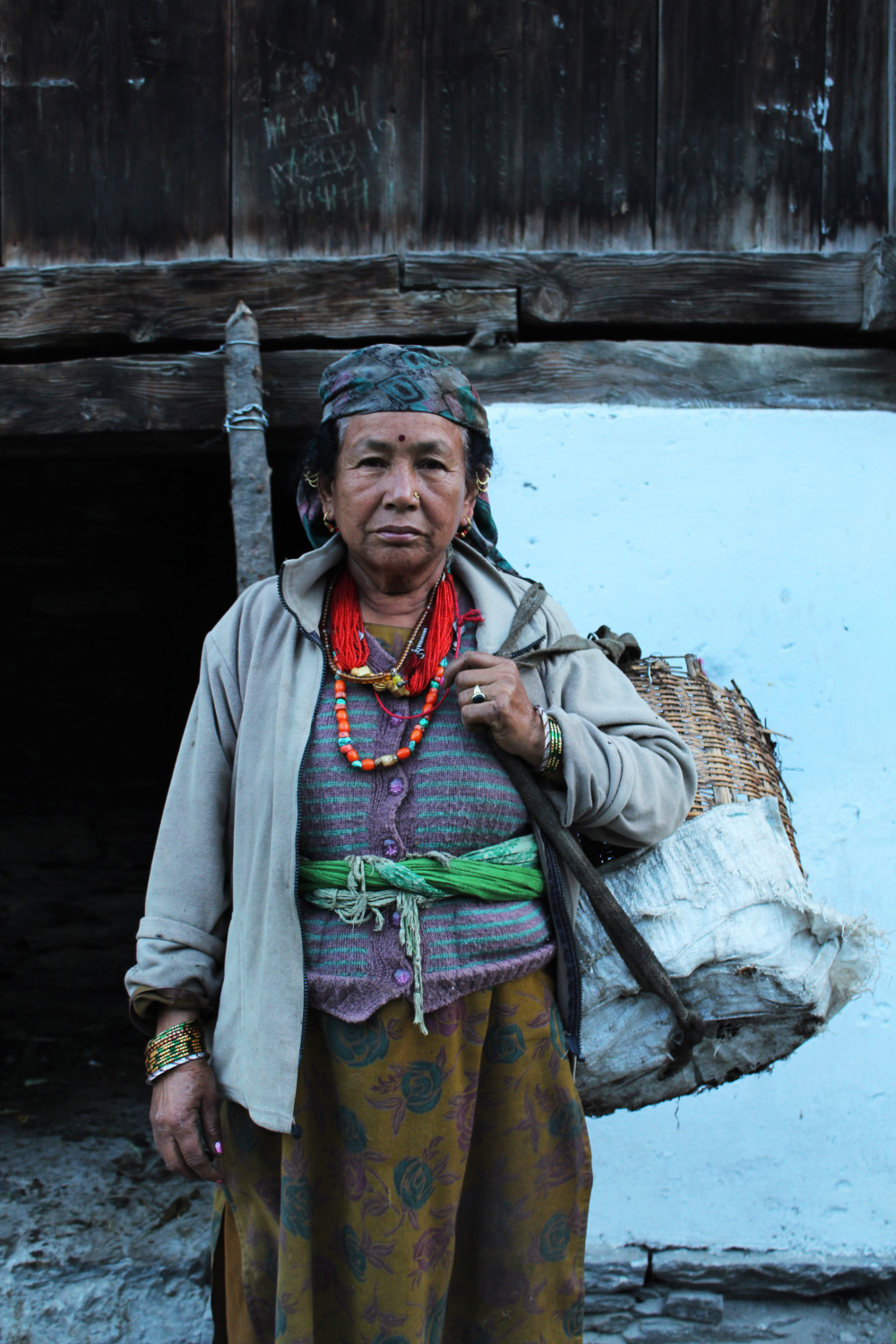
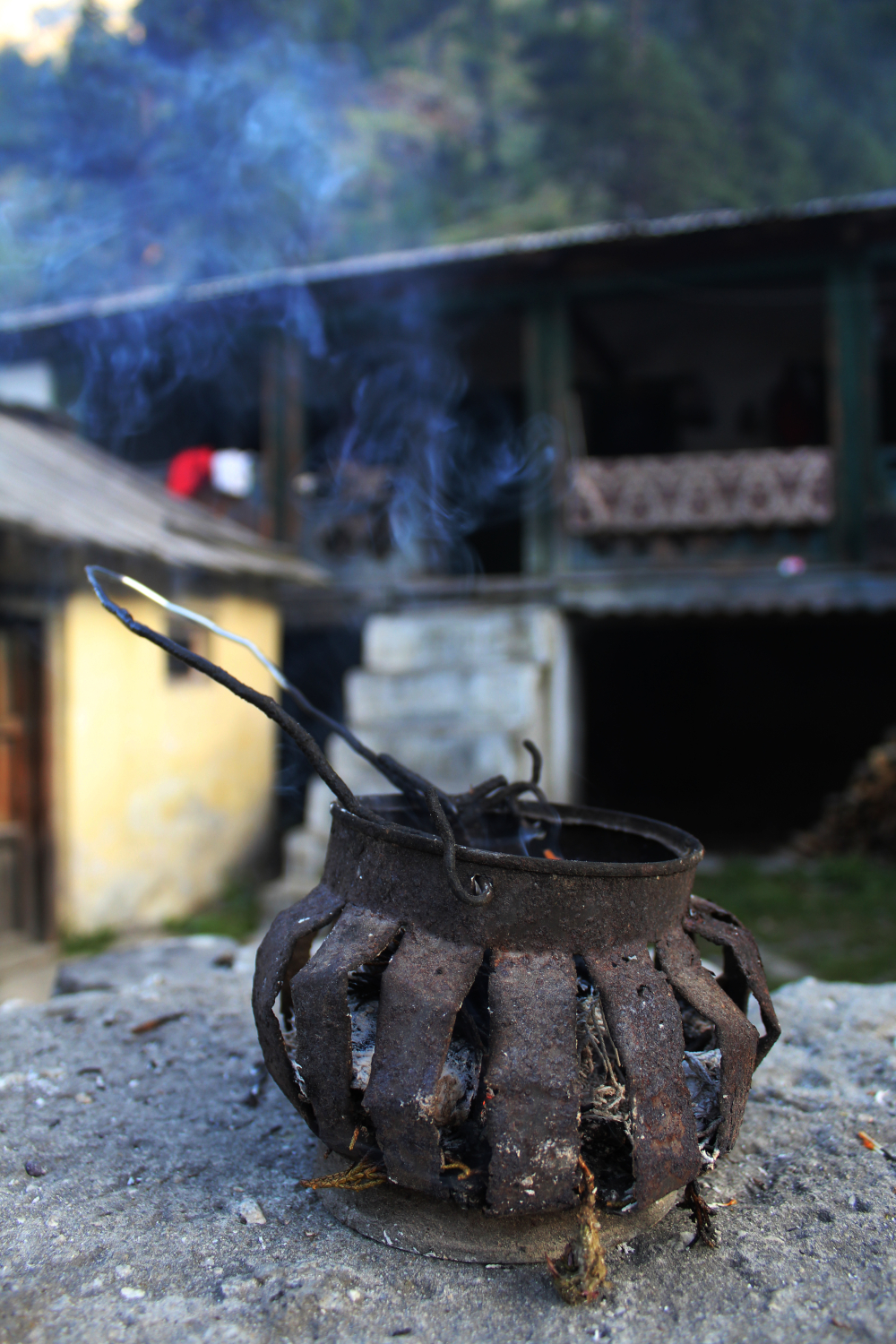
Livelihood and Other Practices
In September, during the sheep rearing season, men and women gather in the common space after breakfast. The men line up to shear the sheep using a traditional scissor-like tool called chambaa (Fig 5). During this communal event of sheep shearing, women sort and distribute the wool to the respective owners. This forms the social network/system reliance and solidarity of the community. The community retains some of the wool, while most of the raw wool today is sold to the state khadi board and nagar nigam (municipal corporation) for further processing.
Traditionally, Jadh Bhotiyas were a semi-nomadic tribe who adopted multiple occupations related to wool processing. Sheep and goats were considered as wealth in the past. The main occupation of the community revolved around herding sheep, shearing, cleaning, carding, spinning, and weaving. Men of the Bhotiya community were traders and shepherds, responsible for procuring the raw material and traders; whereas women had expertise in weaving and knitting, which are part of processing and producing finished goods. In the past as men were in charge and were gone with the sheep for grazing, a lot of the wool processing was done by the women, which is a practice they continue. In the afternoon, one can see women washing the sheared wool in the canal passing through the village. The washed wool is dried in then the sun (Fig 6), followed by the processes of cleaning, combing, making thread and weaving.
Wool making has always been a communal activity for the Bhotiyas, which also lends them their identity of being a close-knit community. Even today, the community makes pankhi (woollen shawl), patheda (woollen belt), chokhta (woollen blanket), socks, carpets, sweaters, caps and jackets. On some occasions, one can also see the people drying herbs under the sun on the street. Earlier, the community did not have a boundary wall to demarcate the limits of the house. The space between the houses was used as a common space and as an extension of the house. (Fig 7) Women basked in the sun while working together or cleaning the grains.
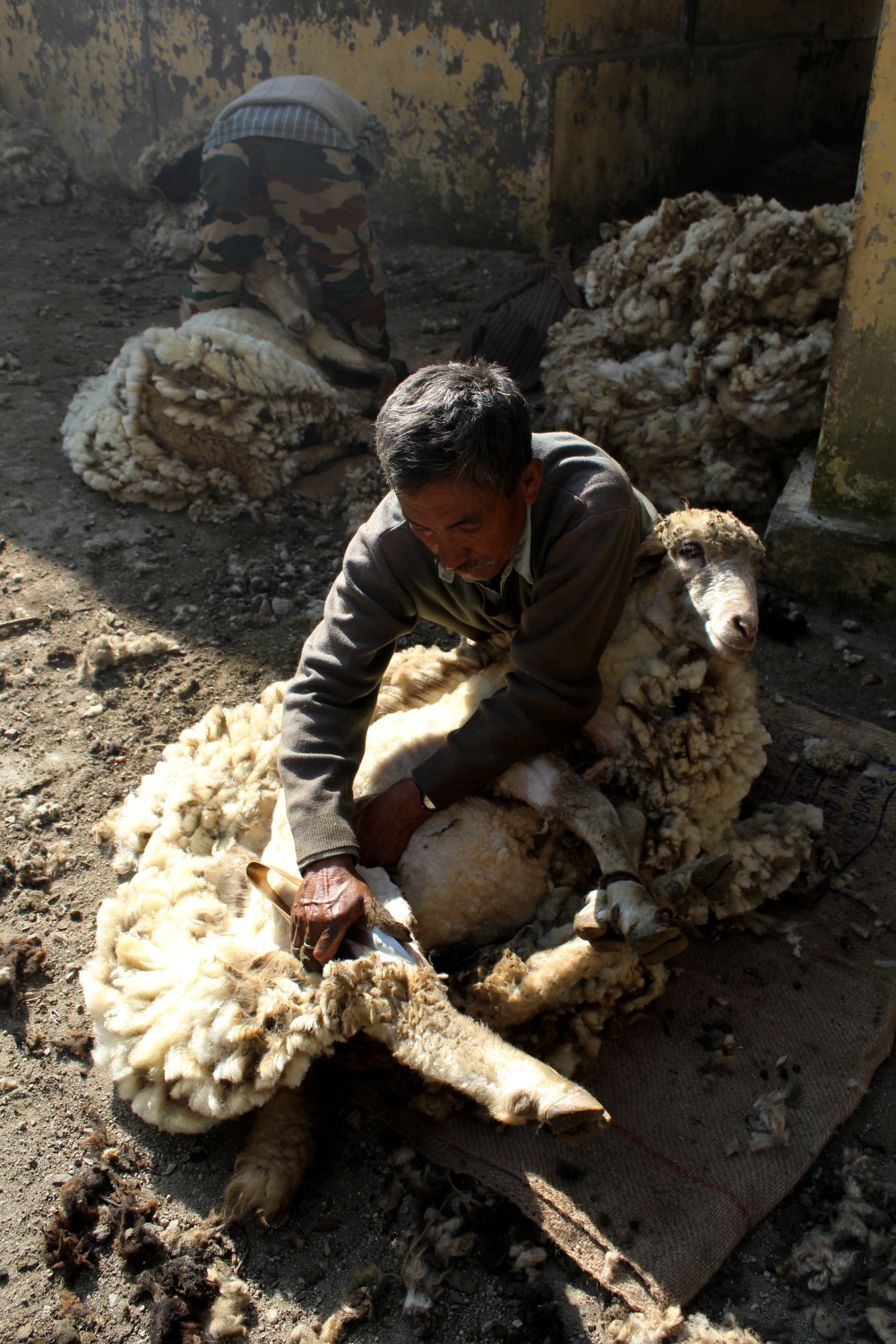
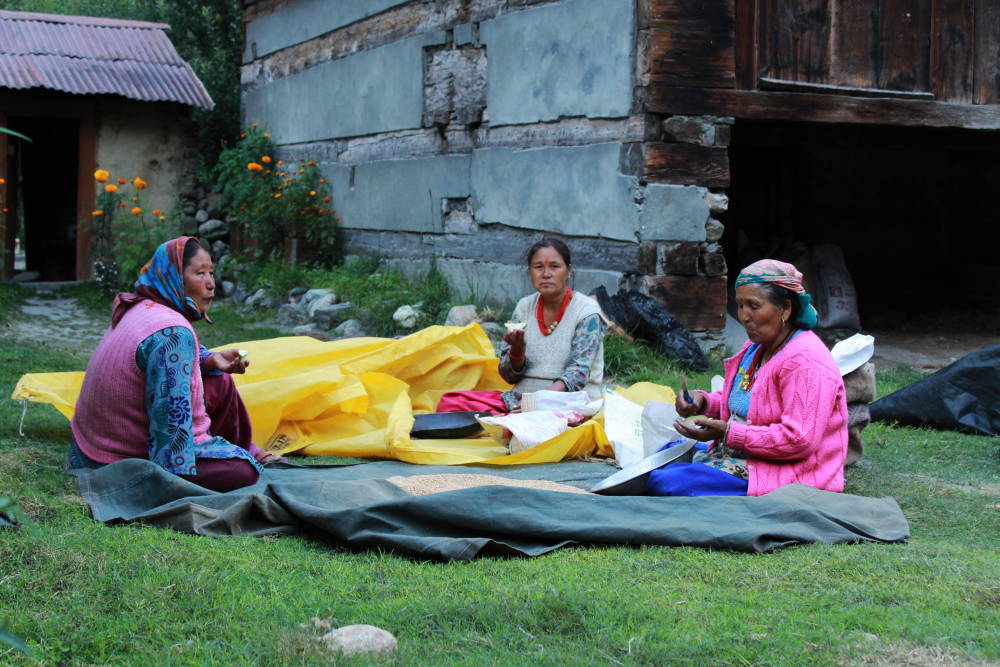
With changing times and migration of the younger generation towards cities, Bhotiyas outsource the shepherds from Nepal. Unable to manage the sheep, most of the villagers have sold off the cattle that was once considered wealth. An elderly community member informed, ‘Earlier, each family had at least have 100–150 sheep, but now it is too hard to manage their fodder, so we sell them. There is only little that we can do alone in old age. Our kids send us money from the cities, and we manage with that.’[4]
The wool-making activities now are carried out by the elders in the village. (Fig 8) With no new takers for the work that defined the Bhotiya lifestyle, in the long run, this may result in the community losing its identity. As when a community loses its traditional livelihood practices, they also lose social and cultural habits passed down through generations.
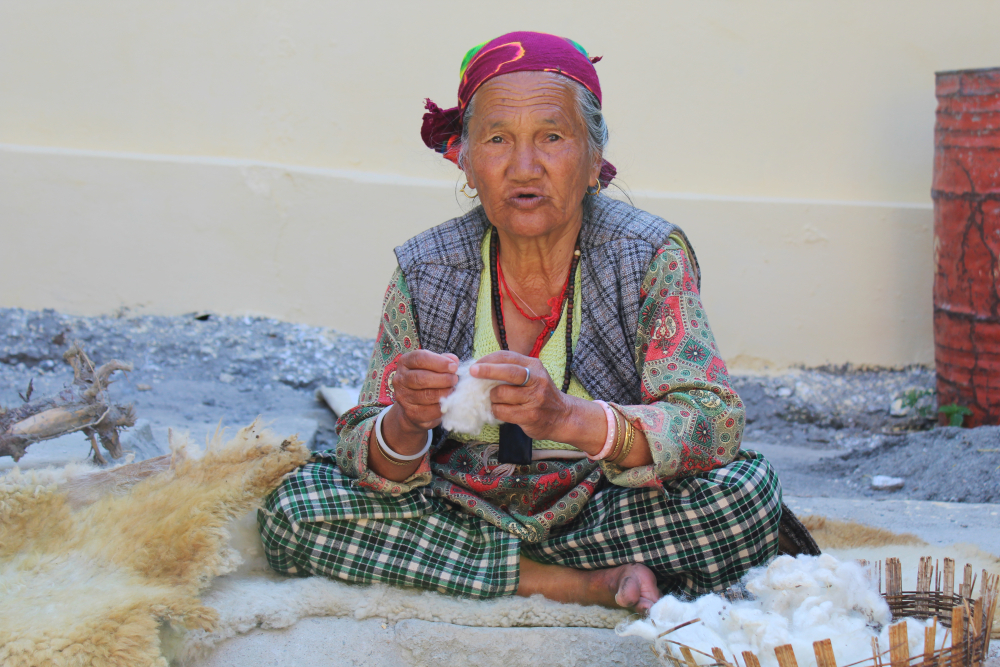
Customs, Rituals, and Festivals
Following relocation of their settlement, the Bhotiya community adapted to Hindu religious practices in addition to Buddhism. Today, the Bhotiyas are followers of Tibetan Buddhism and Hinduism, practicing the rituals of both the religion. They have adopted Lamaism (followers of His Holiness Dalai Lama) and have gravitated towards Hinduism of the neighbours of the south. The village of Bagori has a Buddhist temple called Tsechen Khakhyab Ling, and many temples devoted to Lord Shiva, Ringali Devi (goddess), the Pandavas among others. On particular days, in the late afternoons, women of the community gather to sing bhajans that are dedicated to Hindu gods. This gathering takes place in different houses, on rotational basis.
The Bhotiya marriage rituals are as per the Vedic norms. They take pheras (seven rounds around the fire) while the priest performs havan (sacred fire ritual) and pooja. During festivals, musical instruments like dhol (drums) and ransingha (a type of trumpet made of copper) are played. The community celebrates Hindu festivals like Holi, Diwali, and Shivratri. Along with this, the Bhotiyas celebrate the Tibetan Buddhist new year, Losar in February. Bhadar (the sixth month of the Hindu calender) or Sargin is celebrated in September; for this, a child who is believed to be a form of Lord Yasanga arrives from Himachal Pradesh. During Bhadar, the child possessed with the spirit of Lord Yasanga dances to the beat of the drums and pierces his cheeks with two–three needles.[5] The Bhotiyas also celebrate Pandav dance in the month of October before Diwali, during which some villagers are possessed by the Pandavas and Draupadi. The possessed people dance to the beat of the drums. During festivals, the Bhotiya people wear traditional Tibetan dresses.
Traditional clothing
The traditional attire of Jadh women consists of kolak (a long loose shirt/ coat which is green in colour) tied with pegri (belt) for support. Apart from this, they also wear a ghunti (white headscarf) and a pankhi, and jewelleries that include kagali (silver bangles), jhumki (dangling earrings), bulak (nose ring worn at the nasal septum by married women), shishipul (ornament for the forehead), aland and murki (multiply looped earrings), churu (a neckpiece made up of orange, black, and coral beads, and gold), and kanthi (flat necklace). (Figs 9 and 10)
The men wear woollen cap, woollen coat, woollen trousers and sweater, all of which are woven by the women of the village.
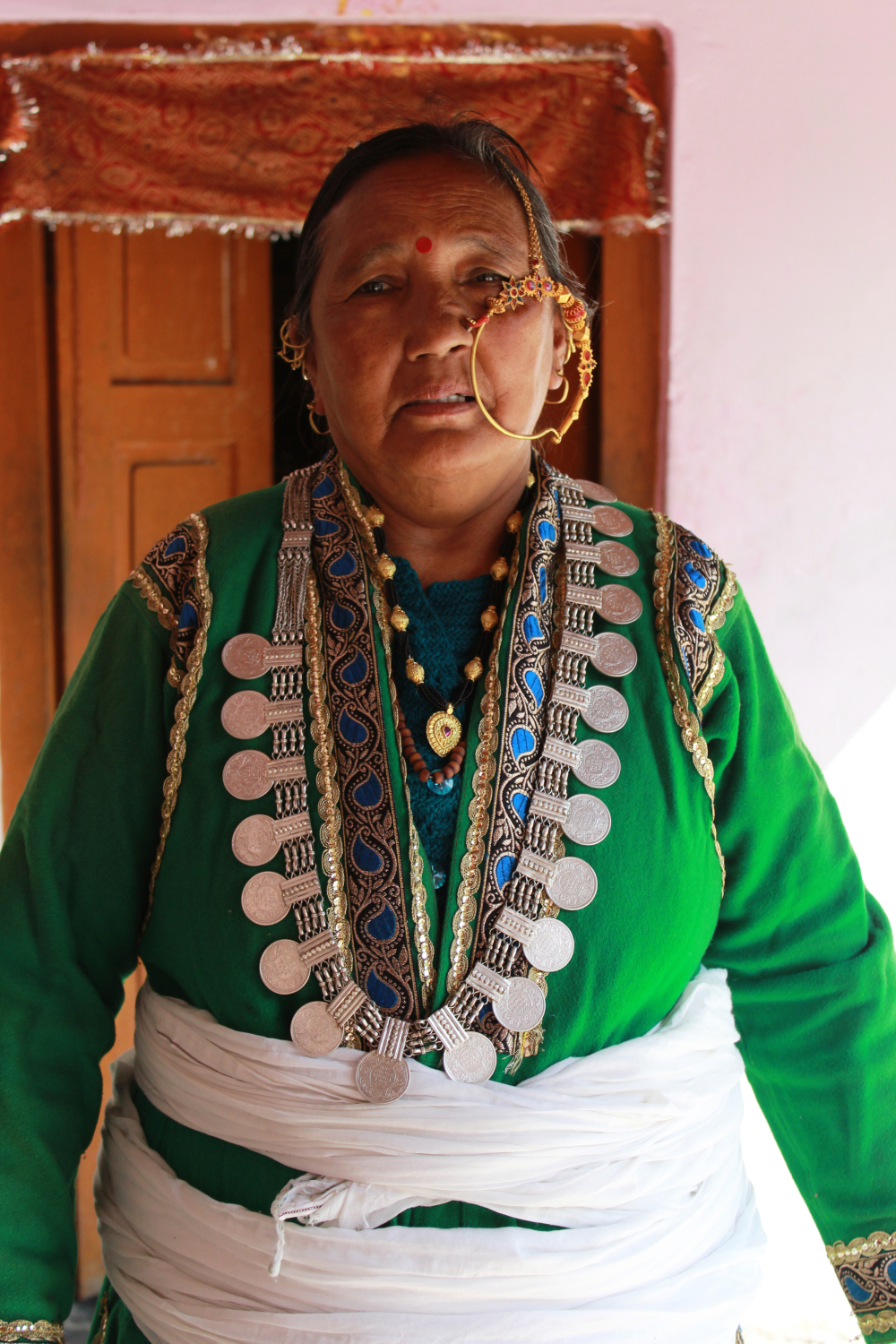
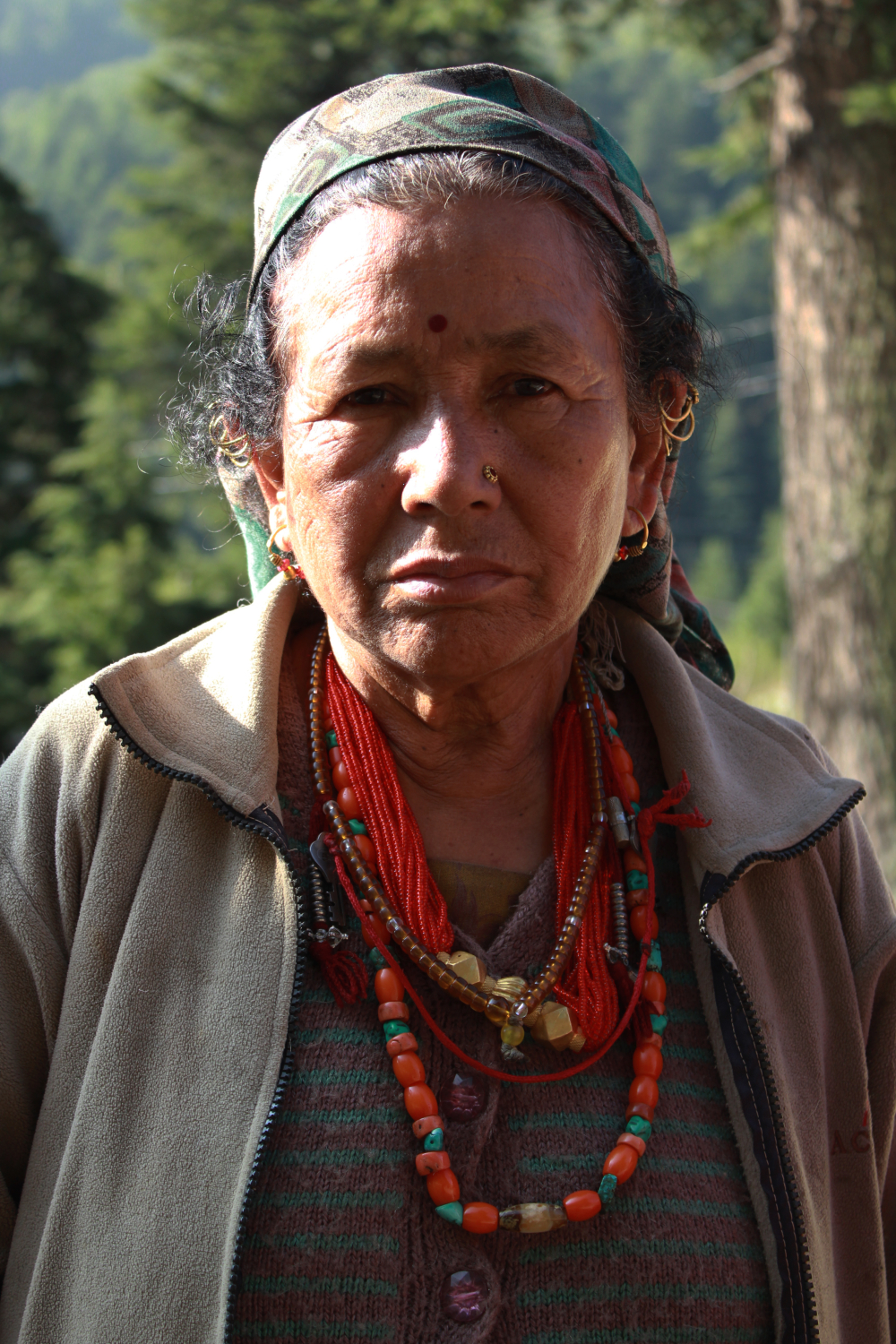
Challenges of the Community
Until the recent years, a lot of cultural influences and practices were like Jakob Michael Hagopian’s documentary called ‘Himalayan Holiday’ shot in 1955.[6] This documentary shot before the 1962 Indo-China war gives an insight into the transhumance lives and practices of the Bhotiya Community. However, the rich cultural diversity of the Bhotiya community is fading due to rapid social, demographic, cultural and economic transformations. Due to lack of means for livelihood, limited economic opportunities and limited aid from the administration, there has been massive outward migration in recent years, resulting in partial 'ghost villages’ in the region. Today, with limited animal husbandry options and agricultural land, the Bhotiyas not only struggles for economic sustenance but also face social, racial, and occupational exclusion and extinction. The drastic collapse of community-based resource management (animal husbandry) has impacted the traditional livelihood systems and practices leading to negative cultural-ecological impact. Recent rapid social, demographic, environmental, cultural, social, economic changes in the community, layered with climate change and increasing disasters in the region, add to the negative impacts, threatening the existence and culture of the Bhotiya tribe. If unattended, these changes can lead to an irreversible negative impact causing loss of the identity of the community, their traditional knowledge and skill.
Notes
[1] Negi, S. S., Discovering the Himalaya (Vol. 1); Bergmann, Gerwin, Nüsser, and Sax, ‘Living in a High Mountain Border Region: The Case of the ‘Bhotiyas’ of the Indo-Chinese Border Region’.
[2] Stein, Tibetan Civilization. 30-31.
[3] SPPEL, ‘Language Documentation, Jadh Documentation’, Scheme for Protection and Preservation of Endangered Languages. Accessed January 12, 2021. https://www.sppel.org/jaddoc.aspx
[4] A Bhotiya Community member in conversation with the author, September 2019.
[5] Oral Testimony Programme of the Panos Institute, Panos' Oral Testimony Programme, accessed October 10, 2019, http://mountainvoices.org/india.asp.html.
[6] Hagopian, M. J., 1955. Internet Archive. Accessed January 18, 2021, https://archive.org/details/cmapr0082.
Bibliography
Chahal, S.M.S., P. Singh, H. Singh, R. Bansal, and I.J.S. Bansal. 'Genetic Variation and Structure of the People of Uttarakhand, Central Himalayas, India.' Human Biology (2008): 409–34.
Chatterjee, Bishwa B. 'The Bhotias of Uttarakhand.' India International Centre Quarterly 3, no. 1 (1976): 3-16.
Chauhan, Anjali. 'Ethno- medicine of Bhotia tribe in Mana village of Uttarakhand.' International Journal of Sociology and Anthropology 6, no. 10(2014): 296-304. doi:10.5897/IJSA2014.0540.
Dangwal, Dhirendra Datt. 'The lost mobility: Pastoralism and Modernity in Uttarakhand HImalaya (India).' Nomadic Peoples, Special Issue: Mountain Pastoralism and Modernity Historical Approaches 13, no. 2(2009): 84–101.
Dash, Chittaranjan. Social Ecology and Demographic Structures of Bhotias. New Delhi: Concept Publishing Company, 2007.
Farswan, D.S. 'Tribes in Uttarakhand: Status and diversity.' International Journal of Multidisciplinary Research and Development (2017): 89–93.
Gerwin, Martin & Bergmann, . 91-107. . 2012. "Geopolitical relations and regional restructuring: The case of the Kumaon Himalaya, India." Christoph Erdkunde 91-107. doi:10.2307/41759062.
Guha, P.K. 'The Bhotiya of Mana Village: A study on some aspects of demography.' Man in India 77, no. 1(1997): 63–70.
Guha, R. Social Ecology. Delhi: Oxford University Press, 1994.
Hoon, Vineeta. Living on the Move: Bhotiyas of the Kumaon Himalayas. New Delhi: Sage Publications, 1996.
Joshi, Anju, and Neeta Pande. 'Religious norm and traditional practices-A step toward conservation of biodiversity by Bhotia tribe of Johar valley, Pithoragarh, Uttarakhand, (India).' International Journal of Current Research 9, no. 7(2017).
Kumar, A., and Pushplata. 'Vernacular practices: as a basis for formulating building regulations for hilly area.' International Journal of Sustainable Built Environment (2013).
Langenrbach. Don't Tear it Down. UNESCO, 2009.
Rautela, P.,and G.C. Joshi. 'Earthquake safety elements in traditional Koti Banal architecture of Uttarakhand, India.' Disaster Prevention and Management: An International Journal 18, no. 3(2009): 299–316. doi:10.1108/09653560910965655.
Samal, P.K., P.P. Dhyani, and M. Dollo. 'Indigenous medicinal practices of Bhotia tribal community in Indian Central Himalaya.' International Journal of Traditional Knowledge 9, no. 1(2010).
Saraswat, S., and G. Mayuresh. 'Koti Banal Architecture of Uttarakhand: Indigenous Realities and Community Involvement.' Research into Design for Communities 2- Smart Innovation, Systems and Technologies, 2017: 165–77. doi:10.1007/978-981-10-3521-0_1.
Sharma, D. 'Nelang Valley.' Medium, July 1, 2016. Accessed January 10, 2020. medium.com/@dhruv.sharma/nelang-valley-82d15bd2d82.
Singh, N., R. Pasupuleti, and A. Khare. 'Disaster Risk Reduction through the learning of traditional knowledge of built heritage- a case study of village Bagori, Uttarkashi, India.' 10th FARU International Research Conference, Wadduwa, Sri Lanka, 2017.
SPPEL. Scheme for Protection and Preservation of Endangered Languages. 2016. Accessed January 12, 2021. https://www.sppel.org/jaddoc.aspx.
Thakkar, J., and S. Morrison. Matra - ways of measuring vernacular built forms of Himachal Pradesh. SID Research Cell, CEPT University, 2008.











